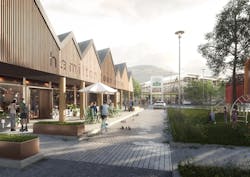Data-Driven Building Design That Gives More Than It Takes
Earth Day this year was unlike any other in the event’s 50-year history. For one, the coronavirus pandemic necessitated a shift from massive public gatherings to a 24-hour virtual event.
More importantly, in early April, global CO2 emissions fell by an estimated 17 million metric tons per day, or 17%, according to The New York Times. In other words, the earth enjoyed a (brief) period of much-needed rest from human activity during the global shutdown we experienced during the pandemic.
The annual Earth Day celebration also signaled the launch of global architecture firm HDR’s Regenerative Design Framework, a data-driven design approach that changes the fundamental thinking about long-term building operations and materials.
The innovative new framework moves beyond basic high-performance design toward renewal-focused impacts and metric-driven targets for carbon, water, nutrients, air, biodiversity, societal and health categories. This holistic approach is intended to flex to accommodate design projects of all sizes, typologies and performance levels.
Understanding that even today’s high-performance buildings have a negative impact on the environment and their occupants, HDR believes it’s time for a collective leap toward a regenerative future, where design has a “net-positive” impact on the environment.
In other words: How do we design buildings that give more than they take?
What Is Regenerative Design?
The term “regenerative” describes a process that mimics nature itself by restoring or renewing its own sources of energy and materials. HDR views regenerative design as design that reconnects humans and nature through the continuous renewal of evolving socio-ecological systems.
That all sounds well and good, but it doesn’t sound particularly measurable. As a data-driven design firm, HDR understands the ambiguity all too well and has created this regenerative framework to address specific questions about metrics.
“A lot of things in the past when you talked about regenerative design were philosophical: ‘You should focus on net positive impact for the site,’” explains Colin Rohlfing, Associate AIA, LEED AP BD+C, director of sustainable development at HDR. “In my mind, and what HDR thinks, is, ‘OK, well, tell me what that means; I want to see the number. What is our water storage capacity? What is our air quality number? We’d like to hit those targets and model to them.’”
That’s exactly what HDR set out to accomplish by designing an online tool to establish and measure very specific environmental impacts based on geographical information survey data tailored to different project sites.
“What we’re trying to do is to look at pristine sites and predevelopment and try to hit those metrics—and that’s for ecological elements, not just energy waste and water, but also air quality, soil chemistry, and biodiversity on various sites,” Rolhfing explains.
The regenerative framework also takes into account community issues, including data on levels of health epidemics, community issues, for example, to determine how projects might impact disadvantaged communities.
“It’s kind of taking the WELL Building Standard, the Living Building Challenge and Triple Net Zero design and pushing them all toward, ‘What should these metrics be to be truly regenerative? Where do we draw the line in the sand and design to that?’” Rolhfing says.
HDR embarked on this project because we are at a tipping point for catastrophic climate change with approximately 10 years left before we start seeing the effects, according to Rohlfing. While the building industry has made progress in terms of advancing sustainable design through LEED or the Living Building Challenge (which Rohlfing notes is “the closest thing we have to regenerative design”), time is running out, and firms like HDR need to push the envelope even further.
[Download our Reopening Schools eHandbook]
“The fact is, we cannot just design to net zero buildings—net zero waste, energy and water,” Rohlfing suggests. “We have to design to net positive impacts. We have to look at what were the pristine conditions before we messed everything up [and ask], ‘What were those conditions, and can we design to those metrics?’ The biodiversity levels, the hydrological impacts of that pristine site is what we’re trying to match.”
How Does It Work?
HDR’s regenerative design framework provides a holistic view of 30 different performance metrics that it feels should be at the center of design. Bringing these focus areas forward as key design goals allows architects and designers to explore “net positive” impacts for carbon, water, nutrients, air, biodiversity, social and health, set achievable goals against existing benchmarks, and consider the project in its broader context.
Here’s how HDR’s regenerative design framework works in practice. Let’s assume you have a project in Los Angeles. The regenerative framework tool will provide existing data on the access to transportation to the site, the existing community and health issues for the region. It also locates a nearby pristine site, such as a national park or forest, as a baseline and issues a report on its air quality, biodiversity levels, hydrology information, as well as carbon sequestration calculations.
“The online tool gives you a snapshot of your site,” Rohlfing says. “Here are the issues of your site, here are the natural, ecological metrics you want to target going beyond Living Building Challenge and LEED—now, go for it. It shows you the range of compliance you want to be in if you truly want to be regenerative. It’s site-specific, and it’s unique to an ecosystem, instead of just saying all projects everywhere hit these targets.”
What Are the Impacts?
When it comes to looking at building performance and energy savings, Rohlfing says it’s possible to come up with calculations to determine costs, ROI, etc. to justify the payback in many locations. However, limiting the focus to just energy, waste and water doesn’t go far enough.
“We can find incentives, we can design the building to be super-efficient, we can do lifecycle cost analysis and say, ‘Yes, this is possible,’” Rohlfing explains. “But with regenerative metrics, we’re trying to hit targets that are above and beyond those elements—not just for energy and carbon, but for biodiversity, water, air quality and health. We’re trying to incorporate those design strategies to hit all those really stringent targets, which in some cases is not justified through traditional payback analysis.”
Most importantly, Rohlfing says the universal metric all buildings should be targeting is sequestering operational and embodied carbon. “You have to be in a positive carbon calculation; otherwise you can’t be considered in a regenerative zone,” he points out.
What HDR has found in the initial projects it has developed using its regenerative design framework is that buildings can actually match or even exceed the level of carbon sequestration of a comparable pristine site.
“That makes me feel good, because if we set that target, our is site actually sequestering more carbon than a pristine site would every time, which I think gets us to the overall regenerative targets for the world a lot faster,” Rohlfing concludes.
Read Next: COVID-19: What You Need to Know About Air Filters

